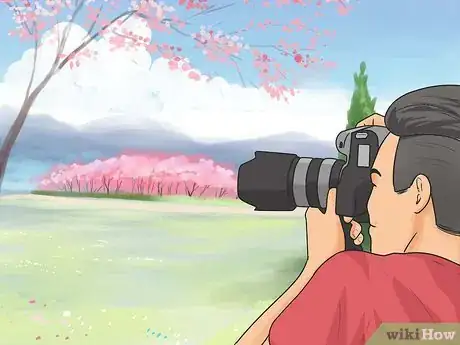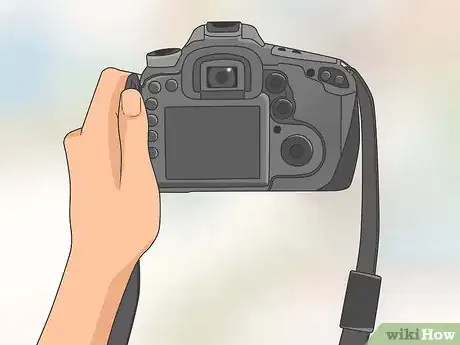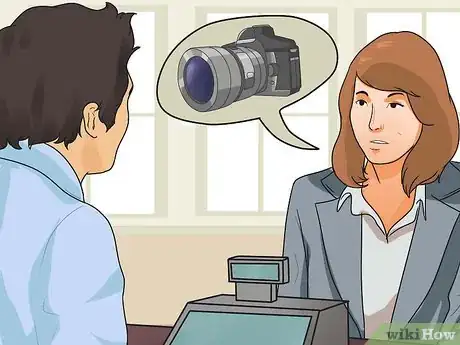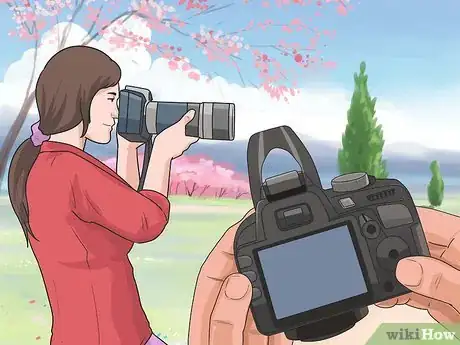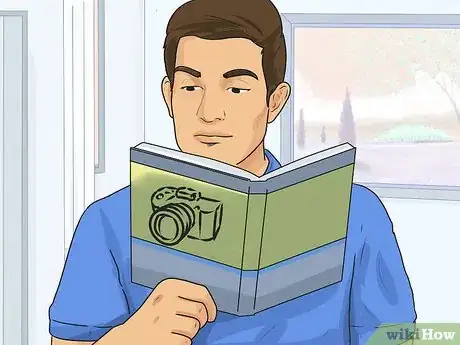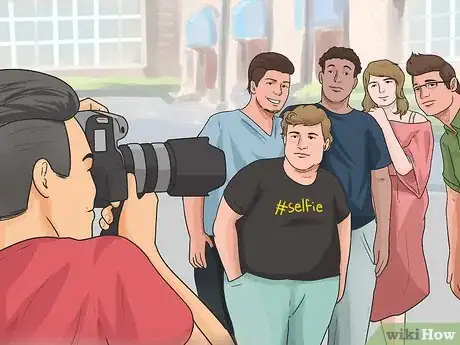This article was co-authored by Stephen Cardone. Stephen Cardone is the COO of NY Headshots, a New York City-based studio that specializes in shooting and producing headshots for individuals and businesses. Stephen has over four years of professional photography experience and over six years of documentary filmmaking experience. Stephen also works extensively as a photographer at NY Headshots. His work includes events, environmental photography, as well as headshots for actors, models, and corporate. He holds a BA in Non-fiction Writing from The New School.
There are 16 references cited in this article, which can be found at the bottom of the page.
wikiHow marks an article as reader-approved once it receives enough positive feedback. This article received 24 testimonials and 100% of readers who voted found it helpful, earning it our reader-approved status.
This article has been viewed 1,384,223 times.
Professional photography is an excellent career choice for anyone who wants to get paid for using their creative talents. It's one of the few fields where age and college degrees aren't as important as a good eye, a quality product, and self-discipline. Photography is a competitive field, so be prepared to start small. Then perfect your craft and build a portfolio of your best work.
Things You Should Know
- To improve your value, build a portfolio, practice your craft, and give your clients exactly what they ask for.
- To build your business, focus on advertising, networking, getting referrals, and saying "yes."
- As you go, make sure to manage your money carefully, always create contracts for your clients, and set rates that reflect your value.
Steps
Focusing on Your Photography
-
1Find your niche. Try multiple areas of photography before settling on one as your favorite. For example, you may focus on portrait, wedding, sport, or landscape photography. Find your area of expertise and use it to your advantage in your business.[1]
-
2Build a complete portfolio. In order to get hired by someone who isn't a close family member or friend, you will need to have a portfolio to show. Use photographs from multiple shoots with different subjects to highlight the range of your talents. Make sure that your portfolio is comprised of more than just five or ten photos. People will want to see the great work you've done.[2]
- If you need to round-out your portfolio with modeling or posed shots, hire amateur models from local agencies. Offer free prints in exchange for free modeling.
Advertisement -
3Develop your photography skills. There is no “right way” or "wrong way" to become a better photographer. Some people take a class or get a college art degree with a photography focus. Others believe that college is a waste of time for becoming a photographer. You may find that you can teach yourself about photography from books and experimentation, or you may want to learn from other professionals. Whatever you decide to choose, if you work for it you can achieve it.
- Take tons of photos! Don't rule out any shots or opportunities to shoot. It's okay if some or many of your photos aren't great. As you take more photos, you'll start to discover your voice as a photographer.
-
4Obtain the appropriate equipment. The type of equipment you need will depend on the type of photography you are doing, but you will likely need one or two camera bodies and a variety of lenses for different situations. You will also need a quality photo editing software.[3]
- You may need additional equipment for lighting or if you want to create an in-home studio. Again, this depends upon your photographic specialization.
-
5Purchase equipment frugally. Having quality equipment is important for taking high-quality photos, but you need not invest all of your savings in brand new, high-end equipment before you really start your career. You can buy used equipment in good working condition, purchase older models at a discount after a new model comes out, rent equipment, or even borrow equipment until you are sure that your business will be successful.[4]
- When you do need to purchase gear, keep track of it for taxes since it is a tax write-off.
- Lenses are often a more important investment than camera bodies as they can be reused if you ever buy a new camera and usually provide a larger jump in image quality.
-
6Know your camera. Before you book your first paid photo session, you should know every setting, error message, and quirk of your camera. You should be able to change lenses with your eyes closed. Fumbling with equipment will make you seem unprofessional and could affect the quality of your final product.
- Read your camera’s manual front to back. The manual will give you a lot of detail about the features and function of your camera in a way that generic photography sources do not.[5]
- To become really proficient, practice extensively at home. Experiment with light and shadow, try different settings on your camera, and learn the ins and outs of taking pictures with your available equipment.[6]
-
7Research camera technology and photography tips. Pick up books, magazines, and online articles for the most up-to-date information on camera settings, tips, and tricks. These will help to teach you new ways to use your camera and lenses to create great photos.
- Make sure you are knowledgeable in how to use your other camera gear, such as a remote flash or different lenses. Having a background in these will significantly improve your photos.[7]
-
8Learn to use editing software. Even the best photos may need some minor editing. Using a quality editing software can take your photos from “good” to “great.”[8] However, be wary of over-doing special effects; your clients may not like photographs that are overly stylized or edited.
- Photoshop, Lightroom, and CaptureOne are great programs for editing photos.
-
9Give clients what they want. You may like to take creative portraits of people, but your clients might just want to look pretty.[9] Remember that, especially when you are starting out, you need to make money. The best way to do that is to have your clients buy prints (or digital images with rights to print). They are more likely to buy prints if they like what they see!
Creating a Business
-
1Intern with a professional photographer. If you are an amateur photographer or you’re just starting out, you should intern or apprentice with a professional photographer to get a sense for how a photography business should be run. It’s likely that you won’t agree with the way your mentor does everything in her business, but it will give you a good idea of the “big picture” of running a photography business.
-
2Develop your “people skills.” Much of running a photography business is working with people. You should work on your ability to talk to people about their visions and goals for a photo shoot, to calm down clients who are angry or disappointed, and to build repeat business.[10]
-
3Set goals. Create several long-term goals. Then, short-term goals that will bring you closer to achieving the long-term goals. The short-term goals should be measurable and have a time frame or deadline. For example, a short-term goal would be to book 5 new clients in the next three months. This could help you achieve a larger goal of having an established clientele within a year.
- Be sure to write down all of your goals. Studies have shown that you're more likely to complete goals that you've written down.[11]
-
4Set up a work schedule. This will largely depend on your client's needs so you'll need to be organized and prepared. When setting up a schedule, consider how long the shoot will need to last and how much time you'll need to edit photos before delivering a product to your client. Realize that some types of photography will demand specific schedules. For example, you'll probably work lots of weekends and evenings if you shoot weddings.[12]
- Remember that one photo shoot includes drive time, photography time, editing time, meeting time, et cetera. Therefore, it is more than just a “1 hour shoot.”
-
5Advertise your business. Create a website, make business cards, network with locals, and talk about your photography business with everyone you meet. Being active on social media will also help you make a name for yourself. Instagram is a great way to post pictures that a lot of people will see.
- Create a watermark to protect your photos so that you can advertise them online. Allow your clients to use your watermarked photos for their own social media sites, essentially doing your advertising for you. Make sure your search engine optimization (SEO) is high for your website so that your business rises to search engine queries.
-
6Say “yes” to new work opportunities. If an opportunity is slightly out of your niche, don’t turn it down outright because it isn’t your ideal work situation. You may find out that you like something that you thought was outside of your comfort zone. However, you shouldn’t feel forced into doing something simply because it represents a business opportunity.[13]
-
7Network with everyone. You should take every opportunity to network.[14] If you are working towards a specific specialization, such as wedding photography, network with everyone in your town who has an association with weddings. Talk to and give your card to wedding planners, cake bakers, caterers, other photographers (they may have a conflict and be asked for a referral), wedding dress shop employees, etc.
- Be prepared to network (professionally) at an event as well. For example, if you do a photo shoot for a wedding, take photos of the food and give them to the caterers. They may use the photos as advertisements themselves, and could recommend you as the photographer who took them.[15]
- Riding on the bus, standing in line at the store, or sharing a table at a coffee shop are all great times for you to advertise your business.[16]
-
8Ask for referrals and repeat business. If someone is happy with the photographs you took for her, ask her to refer you to her friends. Additionally, try to build repeat business; if you took 6-month portraits for a baby, contact the family 4 or 5 months later and ask whether they would like to book a 1-year portrait session. Your business can snowball through word-of-mouth.[17]
Managing Your Business
-
1Keep your day job at first. You will probably not be able to transition from an amateur photographer to a professional photographer in a manner of weeks.[18] It will take time to establish and build business before you begin making enough money to support yourself. As such, you may want to keep another income source until you become established as a professional.
- This might make your life difficult for a while, but you may find that much of your photography work happens during non-work hours anyway. For example, many people schedule family photography sessions on weekends, when their children are out of school.
-
2Organize your documents and files. Before you can begin working as a professional photographer, you need to get your business license and start making yourself a business. Research your state’s or county’s requirements for a business license and the documents you need to have in order to legally call yourself a professional.[19]
- Speak with a small business attorney for a better idea of the specific things you need. For example, if you plan on doing photography solely, make sure you have insurance covering your business. This may include equipment and health insurance for you and your employees.[20]
- You should be meticulous about your record-keeping. Keep contracts, receipts, client emails, and invoices. Organize everything in a way that makes sense to you (by month, by client name, or by location) and consider keeping both electronic and paper copies of the most important paperwork.
-
3Manage your money. Set up a business bank account, create a ledger, and balance your budget. Every week, you should update your ledger with all monetary exchanges you made throughout the last seven days.[21]
- Make sure that you have enough money saved away to pay for at least one entire year’s worth of expenses. This way, should your business fall through or you have a business emergency, you'll have enough money to live on until you get another job.
- Be sure to keep receipts for all business-related expenses. Your accountant can use receipts to calculate tax deductions for your business expenses.
- Remember that (depending upon how your business is legally set up) your income will be subject to self-employment taxes; consider setting aside money from every photo shoot to pay taxes the following year.[22]
-
4Create a contract. Before you agree to go into any photo shoot with someone, make sure that you have a business contract that they must sign. This should include everything that their money is paying for and the things you are and are not liable for. For example, make it clear if you hold liability for photos that are accidentally and irrevocably deleted, or if after signing the contract it is no longer a problem of yours.[23]
- Have an attorney write a contract for you if you want to take the safest path. Joining a photography group also often gives you the opportunity to use a pre-written contract available for group members.[24]
-
5Set your rates. Consider the amount of time required for each shoot, the cost of your gear, the cost of the prints or CD of images as the end product, and your experience. Avoid pricing your photography sessions too high or too low. A price that is too high will scare away most clients, while setting a price very low makes you seem desperate or unattractive as a photographer.[25]
- Look up other local photographers and see what they charge for their own businesses. Then, base your own pricing based off your skills and abilities in comparison to theirs.
Community Q&A
-
QuestionCan you be under 18 to be a photographer?
 Community AnswerYes. It is just easier to starting a small business when you are old enough to find another source of income so you have some starting cash.
Community AnswerYes. It is just easier to starting a small business when you are old enough to find another source of income so you have some starting cash. -
QuestionWhere do I start to be a photographer?
 Community AnswerStart by taking pictures as much as you can, then show them to professionals and ask their opinions so you can learn more about the craft.
Community AnswerStart by taking pictures as much as you can, then show them to professionals and ask their opinions so you can learn more about the craft. -
QuestionWhat degrees do I need in order to become a photographer?
 Community AnswerYou don't need any degrees in order to become a photographer. Pursuing a degree in photography will allow you to take courses that can be very helpful when learning to become a photographer, however. You will not only learn basic photography, but topics like studio lighting and composition as well.
Community AnswerYou don't need any degrees in order to become a photographer. Pursuing a degree in photography will allow you to take courses that can be very helpful when learning to become a photographer, however. You will not only learn basic photography, but topics like studio lighting and composition as well.
Warnings
- Never delete a photo from your camera until you've viewed it on your computer. It's often hard to tell if an image has minor imperfections or not until you view them full size. Sometimes small mistakes can be fixed in a program such as Gimp or Photoshop, but do not rely on it to correct huge mistakes (i.e. blurry images, clipped highlights, etc.).⧼thumbs_response⧽
References
- ↑ http://www.theguardian.com/small-business-network/2013/jun/26/starting-photography-studio-business
- ↑ http://www.theguardian.com/small-business-network/2013/jun/26/starting-photography-studio-business
- ↑ http://www.theguardian.com/small-business-network/2013/jun/26/starting-photography-studio-business
- ↑ http://photographyconcentrate.com/10-tips-to-save-money-on-camera-gear/
- ↑ http://www.outdoorphotographer.com/how-to/tip-of-the-week/top-ten-ways-to-become-a-better-photographer.html#.VTQB1_mjOSo
- ↑ http://petapixel.com/2013/06/25/how-i-transitioned-from-being-a-hobbyist-to-being-a-pro-photographer/
- ↑ http://blog.chasejarvis.com/blog/2012/03/how-to-become-a-pro-photographer-in-5-easy-steps/
- ↑ http://www.creativebloq.com/software/best-photo-editor-51411752
- ↑ http://improvephotography.com/1521/20-tips-for-starting-a-portrait-photography-business/
- ↑ http://photographyconcentrate.com/26-things-i-wish-id-known-before-starting-my-photography-business-part-1/
- ↑ http://www.forbes.com/sites/85broads/2014/04/08/why-you-should-be-writing-down-your-goals/
- ↑ http://improvephotography.com/1521/20-tips-for-starting-a-portrait-photography-business/
- ↑ http://improvephotography.com/1521/20-tips-for-starting-a-portrait-photography-business/
- ↑ http://petapixel.com/2013/06/25/how-i-transitioned-from-being-a-hobbyist-to-being-a-pro-photographer/
- ↑ http://improvephotography.com/1521/20-tips-for-starting-a-portrait-photography-business/
- ↑ http://digital-photography-school.com/how-to-know-you-are-ready-to-become-a-professional-photographer
- ↑ http://photographyconcentrate.com/26-things-i-wish-id-known-before-starting-my-photography-business-part-1/
- ↑ https://jaygoodrich.com/photographystore/think-becoming-professional-photographer/
- ↑ http://digital-photography-school.com/how-to-legally-become-a-professional-photographer/
- ↑ http://digital-photography-school.com/how-to-legally-become-a-professional-photographer/
- ↑ http://digital-photography-school.com/how-to-know-you-are-ready-to-become-a-professional-photographer
- ↑ http://blog.photoshelter.com/2010/03/the-7-common-tax-mistakes-made-by-photographers/
- ↑ http://improvephotography.com/1521/20-tips-for-starting-a-portrait-photography-business/
- ↑ http://improvephotography.com/1521/20-tips-for-starting-a-portrait-photography-business/
- ↑ http://digital-photography-school.com/how-to-set-the-price-for-your-photography/
About This Article
To become a professional photographer, develop your photography skills by taking classes at a studio or community college. You can also find a mentor to help advise you on the craft as well as the lifestyle of a professional photographer. Experimenting with your own photographs, reading books about photography, or studying other people’s work are other great ways to develop your eye. Depending on the type of photography you’re interested in, you’ll need 1-2 camera bodies, a variety of lenses, and photo editing software. For more tips from our Photographer reviewer, including how to start your photography business, keep reading!
